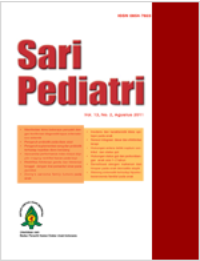Penggunaan Indeks Respiratory-Oxygnation dalam Menentukan Keberhasilan Terapi Oksigen High Flow Nasal Cannula pada Anak Sakit Kritis dengan Distres Napas
Sari
Kata Kunci
Teks Lengkap:
PDFReferensi
Kwon J-W. High-flow nasal cannula oxygen therapy in children: a clinical review. Clin Exp Pediatr. 2020;63:3-7.
Zhao H, Wang H, Sun F, Lyu S, An Y. High-flow nasal cannula oxygen therapy is superior to conventional oxygen therapy but not to noninvasive mechanical ventilation on intubation rate: a systematic review and meta-analysis. Crit Care 2017;21:184.
Rochwerg B, Einav S, Chaudhuri D, Mancebo J, Mauri T, Helviz Y, dkk. The role for high flow nasal cannula as a respiratory support strategy in adults: a clinical practice guideline. Intensive Care Med 2020;46:2226-37.
Prakash J, Bhattacharya PK, Yadav AK, Kumar A, Tudu LC, Prasad K. ROX index as a good predictor of high flow nasal cannula failure in COVID-19 patients with acute hypoxemic respiratory failure: A systematic review and meta-analysis. J Crit Care 2021;66:102-8.
Patel M, Chowdhury J, Mills N, Marron R, Gangemi A, Dorey-Stein Z, dkk. ROX index predicts intubation in patients with Covid-19 pneumonia and moderate to severe hypoxemic respiratory failure receiving high flow nasal therapy [Internet]. Respiratory Medicine; 2020 [dikutip 23 Maret 2021]. Didapat dari: http://medrxiv.org/lookup/doi/10.1101/2020.06.30.20143867.
Sachdev A, Rauf A. High-flow nasal cannula in children: A concise review and update. Dalam: Critical Care Update 2019. Edisi ke-3. ISCCM; 2019.
Frizzola M, Miller TL, Rodriguez ME, Zhu Y, Rojas J, Hesek A, dkk. High-flow nasal cannula: impact on oxygenation and ventilation in an acute lung model. Pediatr Pulmonol 2011;46:67-74.
Goligher EC, Slutsky AS. Not Just Oxygen? Mechanisms of benefit from high-flow nasal cannula in hypoxemic respiratory failure. Am J Respir Crit Care Med 2017;195:1128-31.
Kelly GS, Simon HK, Sturm JJ. High-flow nasal cannula use in children with respiratory distress in the emergency department: Predicting the need for subsequent intubation. Pediatr Emerg Care 2013;29:888-92.
Kawaguchi A, Yasui Y, deCaen A, Garros D. The Clinical Impact of Heated Humidified High-Flow Nasal Cannula on Pediatric Respiratory Distress: Pediatr Crit Care Med 2017;18:112-9.
Milési C, Boubal M, Jacquot A, Baleine J, Durand S, Odena MP, dkk. High-flow nasal cannula: recommendations for daily practice in pediatrics. Ann Intensive Care 2014;4:29.
Yildizdas D, Yontem A, Iplik G, Horoz OO, Ekinci F. Predicting nasal high-flow therapy failure by pediatric respiratory rate-oxygenation index and pediatric respiratory rate-oxygenation index variation in children. Eur J Pediatr 2021;180:1099-106.
Nascimento MS, Quinto DER, Zamberlan GC, Santos AZ dos, Rebello CM, Prado C do. High-flow nasal cannula failure: can clinical outcomes determine early interruption? Einstein São Paulo 2021;19:eAO5846.
Besnier E, Hobeika S, Nseir S, Lambiotte F, Cheyron D, Sauneuf B, dkk. High-flow nasal cannula therapy: clinical practice in intensive care units. Ann Intensive Care 2019;9:98.
Roca O, Messika J, Caralt B, García-de-Acilu M, Sztrymf B, Ricard J-D, dkk. Predicting success of high-flow nasal cannula in pneumonia patients with hypoxemic respiratory failure: The utility of the ROX index. J Crit Care 2016;35:200-5.
Hill NS, Ruthazer R. Predicting outcomes of high-flow nasal cannula for acute respiratory distress syndrome. an index that ROX. Am J Respir Crit Care Med2019;199:1300-2.
Chang C-C, Lin Y-C, Chen T-C, Lin J-J, Hsia S-H, Chan O-W, dkk. High-flow nasal cannula therapy in children with acute respiratory distress with hypoxia in a pediatric intensive care unit–a single center experience. Front Pediatr 2021;9:664180.
N. Kannikeswaran, P. Whittaker, U. Sethuraman. Association between respiratory rate oxygenation index and need for positive pressure ventilation in children on high flow nasal cannula for bronchiolitis. Eur J Pediatr 2022, doi: 10.1007/s00431-022-04607-4.
Lece V Webb, Rouba Chahine, Inmaculada Aban, Priya Prabhakaran, Jeremy M Loberger. Predicting high-flow nasal cannula therapy outcomes using the ROX-HR index in the pediatric ICU. Resp Care. 2022. Doi: 10.4187/respcare.09765.
DOI: http://dx.doi.org/10.14238/sp24.5.2023.352-8
Refbacks
- Saat ini tidak ada refbacks.
##submission.copyrightStatement##
##submission.license.cc.by-nc-sa4.footer##
Email: editorial [at] saripediatri.org


Sari Pediatri diterbitkan oleh Badan Penerbit Ikatan Dokter Anak Indonesia
Ciptaan disebarluaskan di bawah Lisensi Creative Commons Atribusi-NonKomersial-BerbagiSerupa 4.0 Internasional.




